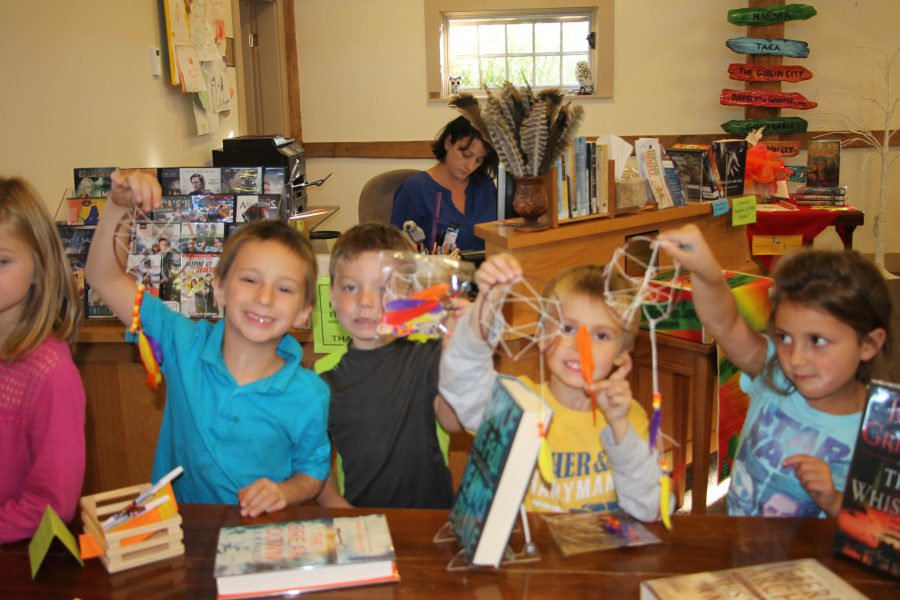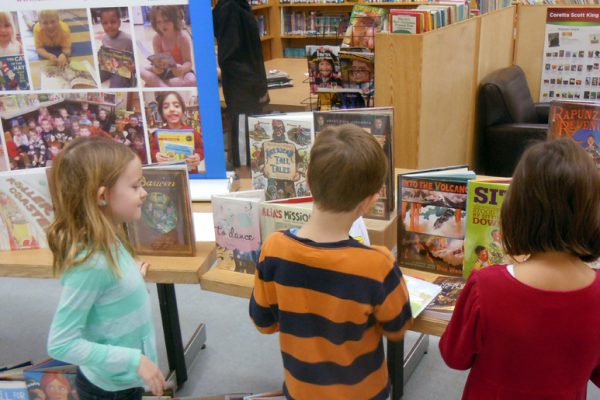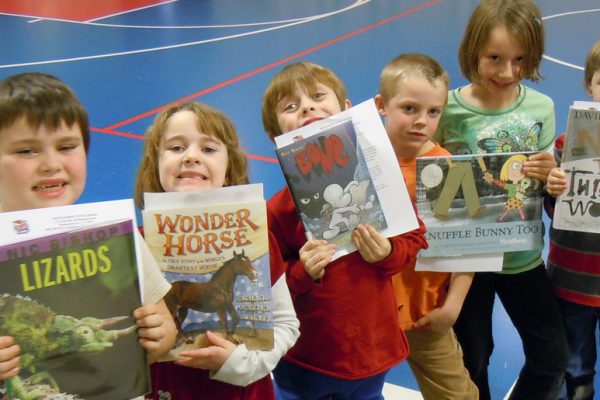
As schools, libraries, afterschool programs, and preschools ramp up for fall, we wanted to share some low-cost literacy program ideas that CLiF partners generated last year. Many of our grants now include an additional program component. The ideas listed here came from these CLiF opportunities:
- Last winter, CLiF added a $500 Revive grant to any organization who had received a CLiF grant within the last 5 years
- $250 program grant that is part of the larger Rural Libraries grant
- $400 mini grant for teachers that is part of Year of the Book
Many of the grants supported book purchases and author visits – so exciting for kids and parents. The ideas presented here are intended to get educators, librarians, and program leaders thinking about how a relatively small amount of money can fund literacy programs that also meet larger goals (a later blog post will provide tips for looking for those funds!).
Goal: Connect with the Public Library ($250)
A childcare center held a family literacy event at the public library to celebrate the Week of the Young Child. Following readings of Pete the Cat: I Love My New Shoes and Stone Soup, participants enjoyed a themed activities including tossing bean bag vegetables into soup pots, veggie stamping, decorating shoe cutouts, painting with shoe-shaped sponges and washing Pete’s shoes in bubbles. They chose to partner with the library so that “…families could become more familiar with the library and more comfortable going there on their own. Some of the families had never been to the library.”
Outcome: “One little girl (age 5) who came to our family literacy event with her father and sister had never been to the library before. She listened to and participated in the read-aloud stories, took part in all of the themed activities and created a handful of projects/artwork to take home. When one of the teachers handed the child her free book, she looked at the teacher and said, ‘We are the luckiest girls ever!!'”
Goal: Help Parents Engage with Kids ($250)
The grant allowed the public library to add book bags to promote whole environment learning. For example, the bug bag contains three books about bugs, a set of butterfly life cycle figures, and a bug viewer kit. Families can read the books about bugs, but also use them to help children identify bugs in their environment. Other bag topics include fairy tales and space.
Outcome: “This helps us to teach parents ways to learn with their children outside of literature sources. After the first two weeks in circulation, the kits had been checked out 9 times, some with reserves on them already. ”
Goal: Talk About Books with Kids ($250)
Two libraries tackled this in different ways: one hosted a series of book talks organized for kids by age and another started a book group for kids aged 8-14. Both built up their collections and hosted an event with snacks. The librarian invited the town rec program to the book talks.
Outcome: “One of the books I spoke about was The One and Only Ivan by Katherine Applegate…Those who had read the book loved it and talking about what a great story it was…The book talk got children talking and sharing their opinions on books. It was exciting to see and so happy with how successful the programs were….It also strengthened the library’s relationship with the town’s rec program and we hope to have them attend more programs in the future. ”
Goal: Excite Kids About Writing ($250)
One afterchool program offered an 8-week workshop on Slam Poetry, Stand Up Comedy, and Scene writing workshops for fourth to sixth graders. They learned about the different genres, and also created their own pieces during the “enrichment hour” of the afterschool time. Another library offered a create-a-comic workshop.
Outcome: “Students were writing up a storm. Students explored writing individual poems, group scenes, story starters, and more. The group came together to decide what they would like to do for the final celebration, and wrote a scene that they were extremely proud of together. Parents and community certainly enjoyed their short film they made of their writing, but the students were laughing uproariously, clapping, complimenting each other, and had obviously bonded as a group after having written and acted in their own creation.”
Goal: Introduce New Cultures ($250)
One library started Celebrate!, an after-school program occurring once per month for the length of the school year. During each ninety-minute-long program, the librarian introduced a holiday or festival that is celebrated that month by another culture by sharing stories about the origin of the holiday, doing a related craft, and sharing a traditional food. They celebrated Navajo Nation Fair, Diwali in India, St. Andrews Day in Scotland, Moomba in Australia, Children’s Day in Japan and Chinese New Year.
Outcome: “The children loved the program and so did their parents. Several parents have told me that they want to see more programming like this, meaning more programming that introduces their children to the wider world. We live in a small community that is not particularly diverse and parents are coming to the library to introduce their children to the wider world. I think that stories are something that tie cultures and people together and I hope that by introducing children to different cultures and stories, they will be inspired to look for more. ”
Goal: Link Kids to Their Community ($250)
One library planned a community day focused on the namesake of their library. They created a display about his life and military service and encouraged friends and families to record their memories of him. The funding supported food for the event and research and display.
Outcome: “This program was intended to educate this generation and to add emphasis on the Memorial part of our little library and to reinforce our mission statement, ‘A multi-generational community center fostering traditional, cultural and technical literacy.’ All presentations in our space always seem to create more awareness of how much our little space has to offer.”
Goal: Encourage Problem Solving ($200)
Teachers of sixth- through eighth-graders introduced a module called “Design Challenge,” an interdisciplinary ELA and science unit. In this module, students went through the design process (which connects with the science Next Generation Standards) to solve problems, build models, and test their models. Throughout the process, students developed scientific writing skills that are applied to writing lab reports, with a formal lab report written for the final project. The funds covered materials (popsicle sticks, hot glue guns, cups, straws, marbles, PVC piping, etc.) needed to build and test their prototypes.
Outcome: “This is a hands on learning experience which hooked students’ interests! The design process engaged learners throughout the entirety of the writing process, as each step will be broken down into smaller pieces. Students needed to revise their procedure list as they hit roadblocks in the actual building of the process.”
Goal: Celebrate Differences ($250)
The art teacher shared the book Only One You as a catalyst to create pieces of artwork. Students brainstormed together as a class to compile a list of inspiring words to be painted on rocks with colorful patterns and inspirational words. Students saw the rocks every day and used them as reminders of their differences and to embrace them. The stones were placed in the front of the building as a rock garden, and serve as a daily reminder that they are each unique and special!
Outcome: “Students used their incredible artistic ability to paint a unique design on their rock. Students loved their projects so much that they wanted to take the rocks home instead of leaving them as a permanent installation at the school…They absolutely loved the thought of painting a physical piece of artwork that was small enough to take with them in their pockets.”
We at CLiF can not wait to hear what you will do this year!



